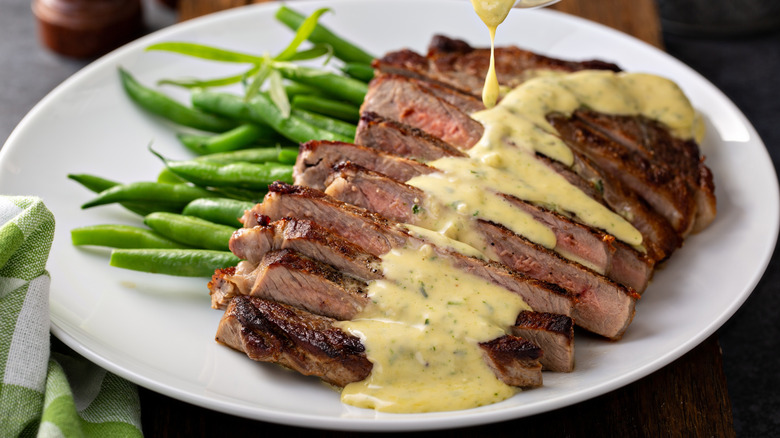What Makes Foyot Sauce Different From Classic Béarnaise
In the realm of culinary indulgence, Foyot sauce stands as a timeless classic that adds a touch of elegance and decadence to the world of steak. This velvety and rich sauce, with its origins rooted in French gastronomy, is a beloved companion to perfectly cooked cuts of beef, elevating their flavors to new heights.
Also known as sauce Foyot or sauce Valois, Foyot sauce is a delightful marriage of Béarnaise sauce and glace de viande, a rich, reduced meat stock. It boasts a harmonious combination of tangy and buttery notes, balanced by the deep and savory essence and unctuous mouthfeel of the glace de viande. The result is a luscious, smooth sauce that gracefully coats the palate.
Though the exact history of Foyot sauce is murky, it was likely created in the mid to late 19th century, as Béarnaise sauce itself wasn't invented until 1836. It quickly became a favorite accompaniment to steaks, enhancing their taste with its velvety texture and savory depth. Over the years, Foyot sauce — like Béarnaise — has retained its status as a classic sauce, beloved by chefs and diners alike for its ability to elevate and add a touch of indulgence to meat and other dishes.
How are Foyot and Bearnaise sauces different?
While Foyot sauce and Béarnaise sauce share a common ancestry in French culinary traditions, these two classic sauces possess distinct characteristics that set them apart in both flavor and preparation.
Béarnaise sauce, revered for its silky texture and tangy yet rich profile with verdant accents, is a revered accompaniment to steak and other meat dishes. It is crafted from a reduction of vinegar, white wine, shallots, and tarragon, which is then emulsified with egg yolks and blended with melted butter. The result is a creamy and tangy sauce with prominent herbal notes, elevating the savory flavor of meat with finesse.
On the other hand, Foyot sauce is a "child" sauce of Béarnaise sauce — itself a "child" of Hollandaise sauce — meaning it is a variant of the latter that adds to the original flavor profile. Foyot adds to the tanginess of Béarnaise with the velvety essence of glace de viande, creating a more complex and savory profile.
When to use Foyot and Bearnaise sauces
With two sauces so similar, it can be difficult to know when to properly deploy them. When deciding between Foyot and Béarnaise, consider the nature of the dish you are preparing, such as the depth and qualities of its flavor alone. Both hailing from the realm of classic French cuisine, possess their own distinct flavors and pairings, offering culinary enthusiasts a choice between indulgent variations when it comes to elevating their dishes.
Béarnaise sauce, with its brighter profile, is an ideal match for various grilled or roasted meats. It shines brightly when drizzled over a perfectly cooked steak, enhancing its natural flavors and adding a luxurious touch. Béarnaise sauce also complements poached fish, grilled chicken, and even vegetables like asparagus or artichokes, bringing a burst of richness to the plate.
On the other hand, Foyot sauce, with its infusion of demi-glace, steps into the spotlight when a deeper, more robust flavor is desired. This sauce shines when paired with heartier cuts of beef, such as ribeye or filet mignon, as well as roasted game meats. Foyot sauce's velvety texture and savory essence create a symphony of flavors that envelops the meat, delivering a truly indulgent dining experience.
Ultimately, the decision to use Foyot sauce or Béarnaise sauce lies in personal preference and the desired dining experience. Both sauces offer an elevated touch to dishes, showcasing the artistry of classic French cuisine.


